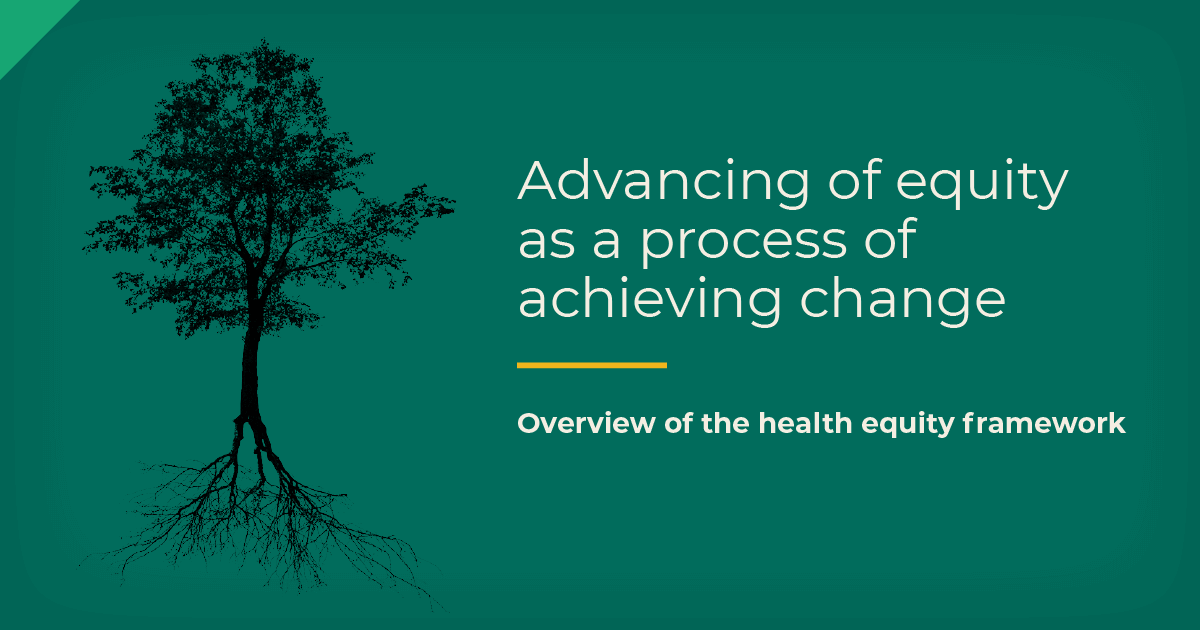In response to our blog post describing the levels at which we can work to advance health equity, our colleagues, partners, and friends asked us, how does this framework translate into action? That is, what does implementing activities and progress at these levels look like in practice?
Although many conceptual models depict where and how to approach work in pursuit of health equity, we offer one that maps to the levels of our framework and provides specific insights into interventions needed to advance health equity at each level. In particular, we present a theory of change that provides the basis for understanding how to assess progress by explicitly stating the assumptions and components needed to effect change. We use theories of change to underpin our work, including strategy development and monitoring, evaluation, and learning. Practitioners, researchers, policymakers, and other decision makers can adapt our theory of change to determine where to invest time and resources to advance equity and to assess the effectiveness and impact of these investments.
Our theory of change depicts the types of actions needed to effect change related to the following key concepts:
- Structural determinants—policies and systems
- Social determinants—local environments and norms
- Quality and use of services—content, composition, and coordination of resources
Below, we further describe the pathways to change and provide examples of actions at each level.
Health equity
The Result: Individuals’ health and well-being
Quality and use of services
Non-discriminatory high-quality services
Social determinants of health
Timely, resources available to all throughout the life course
Structural determinants of health
Equitable distribution of power and resources
Overview of the
health equity framework
Social determinants of health
Advancing of equity as a process of achieving change
We visualize this pathway through a framework of key concepts represented by a tree, beginning at its roots (root causes) and ending with it bearing fruit (health and well-being). Each part of the tree presents different opportunities to influence health and well-being; we can conceptualize our health equity work along the change pathway based on how it impacts various drivers of health.
For example, our work may reduce disparities in the quality and use of services or address social and structural determinants of health.
Structural determinants of health
Equitable distribution of power and resources
Build community power

Social determinants of health
Timely, resources available to all throughout the life course
Improve community conditions and access to services

Quality & use of services
Non-discriminatory
high-quality services
Facilitate whole-person,
person-centered service delivery

Health equity
The Result: Individuals’ health and well-being
Framework helps illuminate the pathway to achieving health equity
Better visualize and understand the intertwined roles of policy-related, systemic, community, and individual factors.
Acknowledge the legacy of health inequity and understand the mechanisms by which that inequity was created.
Provides insights into actions needed to strengthen health systems operations.
Change pathway for structural determinants of health: Build community power to dismantle policies and systems that perpetuate inequities and replace them with policies and systems that redistribute power and resources equitably.
To change policies that were developed to favor one group over another, people from disenfranchised groups must have a voice. When affected communities come together and organize—building a base of leaders to advance the needed change—these voices generate power. Community organizing and base-building centers on a shared story, commitment, strategy, and goal. Coalitions, groups of organizations aligned in a common purpose, and decision makers with the ability to effect change and redistribute power can further amplify the voices of organized communities. Communities can build coalitions centered on community-driven goals and work with existing coalitions that have a shared purpose. The goal is to increase the influence communities have with decision makers who currently hold the power to change policies and systems. A complementary action, often called grasstops advocacy, usually requires coalitions working directly with decision makers to reach other decision makers. Independently and together, these strategies push for the revision of biased laws and the enactment of anti-biased laws that prioritize the equitable distribution of power and resources and provide restitution for previous harm, thereby addressing structural determinants of health.
States are increasingly using preemption as a tool to suppress local-level policies that aim to advance equity and address structural determinants of health. Preemption is a legislative or regulatory action that a state or federal government enacts to eliminate or reduce the authority a lower level of government has over a given issue. For example, in the southern United States, states have passed policies to preempt local public health measures (such as mask mandates, social distancing regulations, and stay-at-home orders) to reduce the transmission of COVID-19. Localities’ inability to forward such public health measures left Black workers and other workers of color, more often employed in essential industries, with disproportionately higher rates of infection and death than their white counterparts. To combat such misuse of preemption that deepens health inequities, the Robert Wood Johnson Foundation (RWJF) has a long history of funding the collective efforts of state-based coalitions. RWJF’s 2018 grants to oppose preemption funded cross-issue coalitions to build community power through local base-building efforts, litigation strategies, and broad-based coalitions. Before receiving funding from RWJF, many of these coalitions had a long history of opposing harmful preemption bills before they passed—including those related to minimum wage, payday lending, and paid sick leave—allowing localities to determine fair and just payment in their jurisdictions.
Change pathway for social determinants of health: Improve community conditions and access to services in local environments to ensure timely and needed resources are available to historically marginalized groups.
Most initiatives addressing social determinants of health try to increase community capital—that is, the resources and characteristics that interact to enable a community to prosper. These initiatives aim to augment a community’s built, financial, political, social, human, cultural, and natural capital to improve the types and geographic coverage of services available—including enabling services (such as transportation) that give people access to the direct services that they need. However, each person’s social identity, shaped by circumstances and norms, plays a central role in influencing that person’s eligibility for and belief in their inherent right to available services. For example, a job seeker might need child care to fully engage in a job search but cannot afford to pay full price for child care services. Community capital can make service coverage comprehensive, align eligibility criteria with community members’ needs and ability to pay, and help people of all social identities understand their right to obtain resources and optimize well-being.
Boston Children’s Hospital’s Collaboration for Community Health advances its mission to improve the well-being of children and families in local communities by supporting eight initiatives focusing on social determinants of health. Partners in these initiatives work to reduce disparities in housing, food access, economic opportunity, education, and neighborhood environment. Underlying these initiatives is the belief that factors beyond medical care drive health. For example, in the first three years, partners have increased access to affordable housing by raising $4.5 million for the preservation of rowhouses, securing 219 affordable housing units for families of Boston Public School students experiencing homelessness, and facilitating 62 low-interest rate loans for Black and Latinx families. These efforts have stabilized housing to prevent negative child and caregiver health outcomes, such as mental illness, developmental delays, and acute conditions requiring hospitalizations. Among many other accomplishments to address social determinants of health, the initiative has improved access to healthy foods for about 380,000 adults and 90,000 children, screened more than 2,000 children for developmental and socio-emotional progress, and provided educational and career coaching for almost 500 Black and Latinx youth.
Change pathway for quality and use of services: Facilitate whole-person, person-centered service delivery by tailoring the content, composition, and coordination of resources to provide nondiscriminatory high-quality services.
Although we include social services beyond clinical care when discussing how to achieve health equity, the Institute of Medicine’s six domains of quality health care provide a helpful structure for organizing quality of services in any social sector. These six domains conceptualize quality care as safe, effective, person-centered, timely, efficient, and equitable. Successful implementation of such quality services generally requires (1) a sufficiently skilled, diverse workforce to deliver services according to the highest quality standards in all geographies and the removal of service deserts; (2) a supportive infrastructure (building, transportation, and technology) to enable delivery of quality services for all populations, particularly those historically denied high quality care; and (3) an equitable process of care in which an individual’s needs are identified, respected, and understood, and services are tailored accordingly. As a result, interventions to improve quality of services centered on advancing health equity often focus on one or more of these factors.
HealthierHere in King County, Washington, strives to improve the health of its diverse communities. One strategy to promote provision of high-quality care is putting into place patient-centered processes through care coordination. Among its many activities, HealthierHere supported a community listening project that administered 2,700 surveys across 40 communities to gather insights on how to make health care and other social services more responsive to consumers’ needs. In addition, HealthierHere developed workforce skills to counter discrimination in the health care system by training more than 100 clinicians on how to recognize and tackle racism in the health care delivery system. Through this work, health care providers, social service organizations, and communities have learned to identify opportunities, co‐create solutions, and deliver higher quality care. These efforts have resulted in improved trends in asthma, depression, and substance use disorder treatments. HealthierHere continues to work with its partners to further connect systems for whole-person care.
Notably, although our focus on health is the result of where we (the authors) sit in the organization, our theory of change and the interventions highlighted are applicable to advancing equity across sectors, including our work in education, welfare, and other social service areas. Although our work at Mathematica might span multiple social sectors, the common thread is that we center equity in our approach and processes, working at all levels.
Equity is at the heart of our research designs and methods, including the use of community-based participatory research and culturally responsive equitable evaluation principles. We provide strategy development tools and recommendations; technical assistance support for optimal implementation; and monitoring, evaluation, and learning led by our expanding bench of equity researchers across our Health and Human Services units. We partner with organizations committed to change and making progress toward our shared goal of advancing health equity. Importantly, we commit to continued learning and growth as we transform our thinking and practices to shape a more equitable and just world.
By sharing this theory of change and examples of our actions to advance equity, we hope that others will recognize their role in driving change and become intentional about centering equity in their work, as well.



